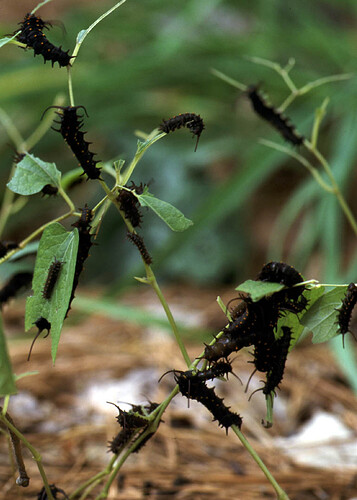Thanks for the info!
In Palisades Park (NE corner of NJ), there are miles of Pipevine growing on the trees and cliffs. During the warm season, the Pipevine Swallowtails are always fluttering around and the caterpillars are everywhere.
In west central NJ, where I live, the Swallowtails are much less common, borderline rare, only coming to lay eggs on the Pipevine we have covering our deck pergola every few seasons.
I have reared several batches of Pipevine Swallowtails from eggs laid in the wild on Virginia Snakeroot, Aristolochia serpentaria (= Endodeca serpentaria), in the lower Piedmont of North Carolina. I always had a problem with the cats eating up all of my Aristolochia, so I offered them Asarum canadense or Hexastylis arifolia, both common plants in my area. No dice–even starving caterpillars refused to nibble either of those plants. Also, I have never found cats or eggs on those two plants, but I find both on the Virginia Snakeroot. The Pipevine Swallowtail is a fairly common butterfly in my area, and there are none of the big Aristolochia vines native in my area, though they are sometimes cultivated. I see the swallowtails oviposit on A. serp. every summer and never on other members of the family–see images. After studying these butterflies in my area for almost thirty years, I can find no evidence they use Asarum or Hexastylis as hosts. A. serp. is a low plant, and easy to overlook, so I think that accounts for the dearth of observations, at least in my area.
Hmm, I think there are many factors involved here.
- As @alanliang said, pipevine swallowtails are extremely conspicuous and they can be noticed by many amateur observers and also they are easily identified.
- As many of you guys said, many other Aristolochiaceae are viable hosts for Battus philenor without belonging to the genus Aristolochia.
- And the last factor: a very large percent of the pipevines used as hosts in the US are cultivated, there are even places where they depend mostly on cultivated plants, particularly where there are no native hosts. Many amateur naturalists don’t know how to identify native Aristolochia (because they are not that fancy and they hide pretty well among he vegetation they creep on, and they are also found in more ‘‘unaccesible’’ habitats, like deep forests or marshes), but they cultivate ornamental species at home. Many, many people cultivate pipevines in the United States, and probably cultivated plants won’t appear as verifiable observations when you search for ‘‘pipevines in the US’’. Or do you guys have more ideas?
Nice pictures of cute caterpillars. Hmm, what you’re saying is interesting, but I don’t know much about those hosts, I live in Southeastern Mexico, and the host I use here is A. pentandra.
Yeah, as already said, those aren’t viable hosts and they are there probably because of misidentification and wandering larvae.
The last three are the most likely in my opinion. I definitely think this is a species that travels a good distance.
Do you have an observation of the pipevine? Because it would not be native to NJ and I would be really surprised it was there in that case. It would have been planted. I haven’t been to the Palisades (yet) but I just checked for observations in the Aristolochiaceae there; the only species observed at the Palisades is Asarum canadense. It’s also suitable habitat for the state endangered Endodeca serpentaria, a preferred host plant for the butterfly, but that is not a vine nor is it often noticed by the public.
Good point. I post the wild plants that bees stop at, but not the cultivated plants. And I try to photograph the wild plants flowering once a season, or when some specific feature like fruit are present, while the bees I photograph much more often, to the point where particular bees with markings that differ show up identifiably in multiple observation. And it is a good thing, sometimes a species of bee I thought I knew is really another in the same genus.
Sorry, no. Given the proximity to massive quantities of people, I’m quite shocked that literally no one on iNat has ever noted the Pipevine. The general Palisades location is called out in butterfly books by Glassberg & Gochfeld & on the NABA website.
I do have tentative plans to be in that area in late spring. I’ll try to remember to snap some pics for iNat while there. The Aristolochia in the park is a different species than the one I grow on our pergola - much larger in every way (leaves, flowers, seedpods, etc).
the butterfly’s might be using some host that is not pipe vine or the inatralist just does not have identifications of pipe vines on the website, which would be quite weird.
Probably it’s not even pipevine and you’re misIDing it.
And something to note here, the answer to the questions is not in just one of all your suggestions. Here there is a clear combination of many, many factors.
The flowers of Endodeca (Aristolochia) serpentaria are inconspicuous, often under leaf litter at the base of the plant in the manner of Hexastylis and Asarum. In the lower Piedmont of North Carolina, they bloom in May.
Good news. This herbarium specimen from Kerry Barringer backs up your claim: https://bry.byu.edu/Herbarium/imgbry/01/0137/BRYV0137424_sm.jpg
I suspect it’s an introduction, somehow, but very cool none the less. Get an observation of it and be the first on iNat for the state!
This topic was automatically closed 60 days after the last reply. New replies are no longer allowed.

